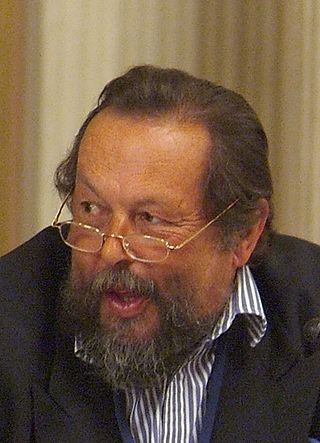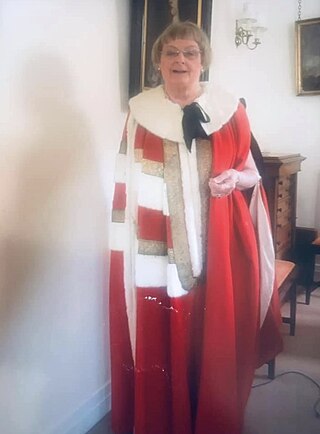
Michael Andrew Foster Jude Kerr, 13th Marquess of Lothian, Baron Kerr of Monteviot,, commonly known as Michael Ancram, is a Scottish politician and peer who served as Deputy Leader of the Conservative Party from 2001 to 2005. He was formerly styled Earl of Ancram until he inherited the marquessate in 2004.

The Peerage Act 1963 is an Act of the Parliament of the United Kingdom that permits women peeresses and all Scottish hereditary peers to sit in the House of Lords and allows newly inherited hereditary peerages to be disclaimed.
The Peerage of the United Kingdom is one of the five Peerages in the United Kingdom. It comprises most peerages created in the United Kingdom of Great Britain and Ireland after the Acts of Union in 1801, when it replaced the Peerage of Great Britain. New peers continued to be created in the Peerage of Ireland until 1898

Alexander Daniel Alan Macmillan, 2nd Earl of Stockton, styled as Viscount Macmillan of Ovenden between 1984 and 1986, is a Conservative Party politician in the United Kingdom. He is the eldest son of the Conservative politician Maurice Macmillan and grandson of prime minister Harold Macmillan, 1st Earl of Stockton.
Barbara Huddleston Abney-Hastings, 13th Countess of Loudoun, was a Scottish countess in her own right, and a member of the House of Lords. Lady Loudoun was the oldest daughter of Reginald Mowbray Chichester Huddleston and Edith Abney-Hastings, 12th Countess of Loudoun. Her father took her mother's last name. Her only brother, Ian Huddleston Abney-Hastings, styled Lord Mauchline (1918–1944), was killed in Italy in World War II, so as the eldest sister, Barbara succeeded to the earldom in 1960.
There are currently two earldoms of Mar in the Peerage of Scotland, and the title has been created seven times. The first creation of the earldom is currently held by Margaret of Mar, 31st Countess of Mar, who is also clan chief of Clan Mar. The seventh creation is currently held by James Erskine, 14th Earl of Mar and 16th Earl of Kellie, who is also clan chief of Clan Erskine.

The House of Lords Act 1999 is an Act of the Parliament of the United Kingdom that reformed the House of Lords, one of the chambers of Parliament. The Act was given Royal Assent on 11 November 1999. For centuries, the House of Lords had included several hundred members who inherited their seats ; the Act removed such a right. However, as part of a compromise, the Act did permit ninety-two hereditary peers to remain in the House. Another ten were created life peers to enable them to remain in the House.

Earl of Rothes is a title in the Peerage of Scotland. It was created in 1458 for George Leslie, 1st Lord Leslie. He had already been created Lord Leslie in 1445, also in the Peerage of Scotland. His grandson, the third Earl, having only succeeded his elder brother in March 1513, was killed at the Battle of Flodden on 9 September of the same year. His son, the fourth Earl, served as an Extraordinary Lord of Session. Lord Rothes was also tried for the murder of Cardinal Beaton but was acquitted.
The hereditary peers form part of the peerage in the United Kingdom. As of August 2023, there are 805 hereditary peers: 30 dukes, 34 marquesses, 189 earls, 110 viscounts, and 442 barons.
The British peerage is governed by a body of law that has developed over several centuries. Much of this law has been established by a few important cases, and some of the more significant of these are addressed in this article.

The Life Peerages Act 1958 established the modern standards for the creation of life peers by the Sovereign of the United Kingdom.

Marjorie Flora Fraser, 21st Lady Saltoun, is a Scottish peer. Until her retirement on 12 December 2014, she was the only holder of a lordship of Parliament who had a seat in the House of Lords as an elected hereditary peer. Lady Saltoun is the Chief of the Name and Arms of Clan Fraser since 1 May 1984, by decree of the Court of the Lord Lyon. She is also the head of the Scottish lowland family the Frasers of Philorth.

Robert Washington Shirley, 13th Earl Ferrers,, styled Viscount Tamworth between 1937 and 1954, was a British Conservative politician and member of the House of Lords as one of the remaining hereditary peers. He was one of the few people to serve in the governments of five prime ministers.
James Thorne Erskine, 14th Earl of Mar and 16th Earl of Kellie, Baron Erskine of Alloa Tower, is a Scottish peer and former Liberal Democrat member of the House of Lords.
Jennifer Jane Forwood, 11th Baroness Arlington, is the daughter of General Sir John Nelson and Lady Margaret Jane Fitzroy, sister of the 9th Duke of Grafton.
Shane William Desmond Alexander, 2nd Earl Alexander of Tunis, styled Lord Rideau between 1952 and 1969, is a British hereditary peer.
Elizabeth Frances Philipps, Viscountess St Davids was a British peeress. Following the passing of the Peerage Act 1963, she became the first woman to take her seat in the House of Lords by virtue of an hereditary peerage as 14th Baroness Strange of Knokin.
George William Beaumont Howard, 13th Earl of Carlisle, styled Viscount Morpeth from 1963 to 1994, is a British nobleman, politician, and hereditary peer.
The first women in the House of Lords took their seats in 1958, forty years after women were granted the right to stand as MPs in the House of Commons. These were life peeresses appointed by the Prime Minister, although countesses had appeared in mediaeval times.









